Isabella grape variety
Isabella is a famous grape with a long history. Its name has long become a household name. A whole group of varieties with common characteristics are called Isabella, and the people even dubbed Isabella all indiscriminately varieties of grapes with a characteristic strawberry taste and aroma. So, for example, Lydia turned out to be "Isabella pink", Noah - "I. white ”, not to mention others similar to our heroine in color and size of fruit.

Such popularity is not accidental, few varieties or hybrid can boast of such wide distribution in the world. This variety can be found in America, Europe, Asia, Africa and Australia. The general geography of its distribution covers more than 150 countries of the world. Until now, our heroine is very popular on the east coast of the United States, in Japan, the island of Bali, Portugal. The most extensive areas occupied by it are located today in Brazil. In the post-Soviet space, plantings are common in Moldova, Georgia, Azerbaijan, the southern regions of Russia and Ukraine. The global spread was facilitated by truly fantastic unpretentiousness and plasticity of grapes, resistance to diseases and pests, ease of propagation of the vine and versatility of the use of the harvested crop. Isabella grows equally well in the tropics and in regions with a continental climate, with excellent frost resistance.
The history of the appearance of this species goes back to the depths of centuries. After the discovery of America, settlers and colonists discovered there wild forms of the vine, belonging to the special species Vitis labrusca. It was favorably distinguished from the cultivated species Vitis vinifera imported from Europe by its adaptability to local living conditions, as well as its high resistance to diseases and pests, which turned out to be especially dangerous on the American continent. The only drawback was a strong specific "labrus" taste and aroma of grapes, which in the wines aged for several years became putrid, which naturally could not satisfy the aristocratic gourmets, while ordinary people liked inexpensive wine, especially since it was not consumed without aging. produces no aesthetic rejection.

Simultaneously with the introduction of Vitis vinifera to America, the opposite process took place - the Labruscot forms were imported to Europe, and together with them hitherto unknown diseases and pests of grapes got to the continent. So in the Old World such extremely harmful diseases in viticulture appeared as mildew, oidium, as well as a pest that is deadly for classic varieties - phylloxera, which not only damages the crop, but destroys the grape plantations themselves. It was after the wide spread of phylloxera that the history of European viticulture was rewritten anew. It could no longer be what it had been for millennia. Vineyards perished en masse on huge areas, and only those American forms that were resistant to a dangerous pest became salvation from this scourge. Overcoming the chaos in the industry went in different ways. So, rich people began to graft cultivars on rootstocks of American grape varieties resistant to phylloxera. The peasants who did not have such an opportunity began to simply propagate the varieties of Vitis labrusca. And breeders, meanwhile, engaged in interspecific hybridization, hoping ultimately to get plants with high yield quality and pest resistance.
However, nature turned out to be quicker than man. Back in 1816, the famous American breeder William Prince discovered in the garden of his friend, a trader from Brooklyn, a natural interspecific hybrid of Vitis labrusca with an unknown variety of Vitis vinifera. He named his find after a friend's wife, Isabella Gibbs.For half a century, the new variety spread without much excitement and attention, but with the onset of the phylloxera epidemic, a real golden age began for it.

Agrobiological characteristics
The mature grape bushes are very vigorous. The leaf is large, three- or five-lobed, rounded, slightly dissected. The leaf blade is dark green in color, below it is greenish-white or gray, covered with dense tomentose pubescence. The lateral notches are open, barely outlined. The petiole notch is open, vaulted, with a sharp bottom. The flower is bisexual, well pollinated by its own pollen.
Isabella's clusters are medium-sized (their weight, as a rule, does not exceed 200 grams), cylindrical or cylindrical-conical, of medium density, sometimes loose. The combs and stems of the berries are short. Berries in the phase of removable maturity are firmly attached to the bunch; when overripe, the attachment weakens, and therefore they may shatter. The berries are medium, round, with a diameter of 17-19 mm and weighing 2-3 grams. The pulp is slimy, yellowish-green in color, with a pronounced strawberry aroma characteristic of the variety. The skin is thick, strong, dark blue, almost black, covered with a thick gray waxy coating, well separated from the pulp. There are 1-2 seeds in a berry.
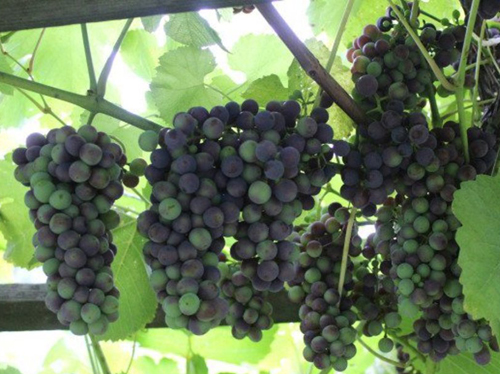
The harvest is used fresh and for the production of ordinary table and dessert wines, juices, and preserves. It can store well for several months in a cool dry place, suspended, or neatly laid in one row on straw or sawdust. The use of Isabella in winemaking for many years has caused unceasing controversy, but more and more producers prefer to abandon the cultivation and processing of a technologically ambiguous variety.
The grapes are late ripening. The growing season from bud break up to removable maturity is 150-180 days. The sum of the active temperatures required by the plant is 3100 ° C. Ripening of shoots is good. Winter hardiness is excellent. The plant can withstand frosts down to -29 ° C without damage. The yield is high - 65-70 kg / ha. Shrubs in arched and arbor cultures give very high yields. With good nutrition and watering, mature vigorous plants can produce 100-250 kilograms of grapes.

A good yield of Isabella, even with a relatively small bunch, is ensured by high rates of shoot fertility (80-90%) and a fruiting factor of 1.8-2.0. It is not uncommon when two or three brushes are formed on each shoot. Fruitful vines appear even on perennial wood from dormant buds, so even if the main eyes freeze, you will not be left without a crop.
The sugar content of the juice of the berries is 16-18%, the acidity is 6-7 g / liter.
Agrotechnical features
In terms of cultivation, Isabella is on top. Few can be found so unpretentious varieties that can grow and give high yields with minimal care. The main distinguishing properties of our heroine are very high resistance to fungal diseases, frost and pests,
The only nuance to which you need to pay attention is to prevent excessive thickening of the bush to provide better ventilation and create optimal conditions for the growth and ripening of the crop. Otherwise, problems with the uniformity of ripening and sugar accumulation of berries are inevitable. Isabella is responsive to watering, providing a moderate load of the bushes and carrying out lightening of the bunches during their ripening. The optimal load is 35-45 eyes per bush, with the length of pruning fruit vines for 3-4 buds.Due to its high growth force and high frost resistance, it succeeds very well in arched culture, it is also used for landscaping.
In the opinion of many lovers of this grape, it is precisely its unpretentiousness and, accordingly, low cost price that causes hatred among producers of classic European varieties, who are unable to compete with it in price. As a result, a real war was declared to Isabella and her related varieties.
Back in 1935, new plantings of isabelle varieties were banned in France. Around the same period, interspecific hybrids were destroyed in Nazi Germany. Even the plants, the Nazis managed to catch in the lack of racial purity, declaring that the hybrid forms of grapes "are representatives of a lower culture."
In the 1950s, the French government began to financially stimulate farmers to uproot isabel plantations, claiming that the labruscans were "relics of the past." Later, in 1979, Paris lobbied for the adoption of a law banning the cultivation of American varieties on the territory of the countries participating in the Common European Market. Since 2008, the EU has already confirmed the ban, demanding that the new members of the European Union fulfill it.
The apotheosis of this persecution was the announcement that isabel wines contain an increased amount of methyl alcohol in comparison with wines from classical varieties. At the same time, it was deliberately left out of the brackets that the difference is completely insignificant, and even the "increased" content easily fits into the existing maximum permissible norm.
Such a protectionist policy and informational stuffing, despite all its absurdity, are doing their job. Manufacturers do not risk getting involved with Isabella because of the very vague prospects for product sales. The only segment where the popularity of the famous variety is still high is in private households. Wine is produced here, without looking back at any prohibitions, "methyl" horror stories and criticism of this grape from fastidious gourmets.
And since there is such popularity, then Isabella will certainly have a future.
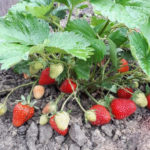
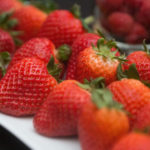
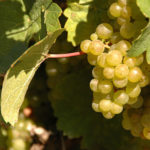
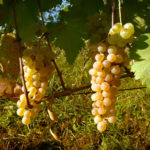
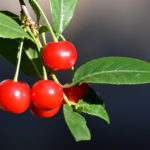
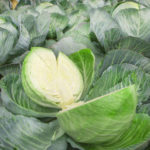



I liked this grape variety very much, both with its delicate aroma and pleasant taste. But in my use it was planted in three different climatic zones (Crimea, Kherson and Central Ukraine). The bushes planted in the territory of Central Ukraine and in the Crimea turned out to be the most fertile. Most likely, the fertility of the soil affected, since no additional care was carried out in addition to irrigation, and this variety showed itself as unpretentious and fertile when planted on fertile and prepared soils.
My grandmother has been growing up for many years. As far back as I can remember, wine was pressed out of it every autumn. It always turned out worthy, and the compotes also went with a bang. The vineyard is always strewn with small bunches. The variety is unpretentious, winter-hardy and requires special care, watering is moderate. During the ripening period, watering is not needed, it can lead to decay of the grapes.
Still, grapes are a southern plant. We have been raising Isabella in the south of the Voronezh region for many years, but still the taste is not the same as that of relatives in the Krasnodar Territory. It seems that the care is appropriate, it does not freeze. It goes well with wine, and it tastes a little fresh when it is fresh. The south is sweeter though.
To be honest, I have this variety growing like weeds (sorry, I don’t want to offend anyone), and it has been growing for a long time. It was planted by my grandfather in the late 80s. The first bole, of course, has already dried up, but since that time I have planted almost the entire yard around the perimeter with Isabella. She serves me instead of a fence. For food, the variety is certainly not very good (tongue cracking). But the crouton from it is amazing. By the way, in the literature they write that in France this grape is considered unsuitable for making wines.
Isabella has been growing on the site for a long time. It is unpretentious and quite suitable for the Black Earth zone. I don't even cover for the winter. It is noticed that in those places where the sun is constant, the berries are much sweeter. There are several plants of these grapes in the garden, but there partial shade and planting serve more to frame the gazebo. Although there are many brushes on them. I like the aroma very much. It tastes a little sour, but we make compote.
This variety was brought to us by relatives from Kazakhstan in the form of cuttings, and we planted them in our country house, not believing that Isabella could survive the winter. But it was a great surprise that in our conditions the grapes survived the winter perfectly and did not require special care. Having planted the cuttings, you need to water them, loosen them between them, weed them. I fed them twice a year, this in spring and summer, once with nitrogen, and once with phosphorus fertilizers. I prune the grapes every year, as it grows very well. Having received the first fruits, well, we thought everything, we will overeat. But, the grapes turned out to be sweet and sour, I would even say sour and it is impossible to eat a lot of it, but the compotes turned out to be wonderful.
This year they found a great way to harvest Isabella. For the first time I can say that this variety is delicious, although it has been growing for 30 years already. We cleaned before the very frosts, when the berries ripened perfectly, pressed the juice (by hand, like on wine), poured it into disposable cups, and into the freezer. When they froze, everyone had to be in a Zipovsky bag, because smears, and to save space, folded in rows to the top.
Of the many varieties that are on my site, only Isabella did not get mildew last season. Therefore, I will replace some varieties with this one. I also like the taste - moderately nutmeg, moderately sweet and tender. And the wine is generally fabulous. Not heavy, like from Moldova, and not tasteless, like from white table varieties. Indeed, a subtle bouquet of aromas and tastes is felt. Unpretentious, not afraid of spring frosts, can be cut in February during the thaw period. In a word, for those who do not want to take a lot of steam on the site, Isabella is just a godsend.
I agree, Isabella grows like wild: all summer, once a week - two have to be pruned and pinched, otherwise by the fall it will strangle all the neighbors. It is a little sick, it is not demanding to care, I don’t cover it for the winter - the plant doesn’t need anything. The yield is excellent, we collect the grapes in buckets (5-6 per bush). Berries do not grow moldy, do not burst, and are not affected by wasps. The best time to harvest is before freezing. It is then that their taste becomes more intense, slightly sweet, the sharp sourness disappears, and can be consumed fresh. But still, the berry is not for everyone, too high acidity of fruits, compotes and wine - the main way of processing.
Isabella has been growing in our country for 30 years - no less. Earlier, when there were no “cultivated” grapes that could withstand our winter frosts, Isabella was considered a normal grape in our country - both fruitful, and tasty, and aromatic. Now no one wants to eat it, but no one is in a hurry to cut it down - the variety has a very powerful root system that does not freeze at all, so Isabella's seedlings are used as a rootstock.Well, of course, wine - the variety is ideal for making homemade wine (and if you pick grapes at different degrees of maturity, you can get wine with different characteristics from one variety).
A variety like Isabella is, in my opinion, the most common. Only the lazy gardener doesn't grow it. Caring for him is minimal, it bears fruit every year perfectly. It is not afraid of winter, does not need fertilizers. Wine and liqueur are obtained with amazing, rich color. By itself, sour, not for everybody. But this is its highlight.
When I lived in southern Kazakhstan, one Isabella bush covered the entire huge gazebo. In the spring, during its flowering, everyone passing by stopped to admire its aroma. The berry is very sweet, yes! The same thing happened during its ripening, and wine is like a liqueur. I remember how some of those whom we treated did not wash their glasses in order to enjoy once again its aroma. The bush was never fed, and the yields were high. Watered almost every day and abundantly. And so, the impression was that it was better than this variety and not naiti, but now, in Greece, where the climate is warm and there is almost no winter, the planted 5 kysts of Isabella behave completely differently; and I do not grow too much, five and fed 3 times (no higher than 2 m), and the yield is average, and the smell is weak, only when eating is felt, the taste is normal, BUT they are constantly sick with mildew (2 bushes have dried up), and this year also fomopsi. Processed 4-5 times. I do not know what to do? Probably have to gouge out.